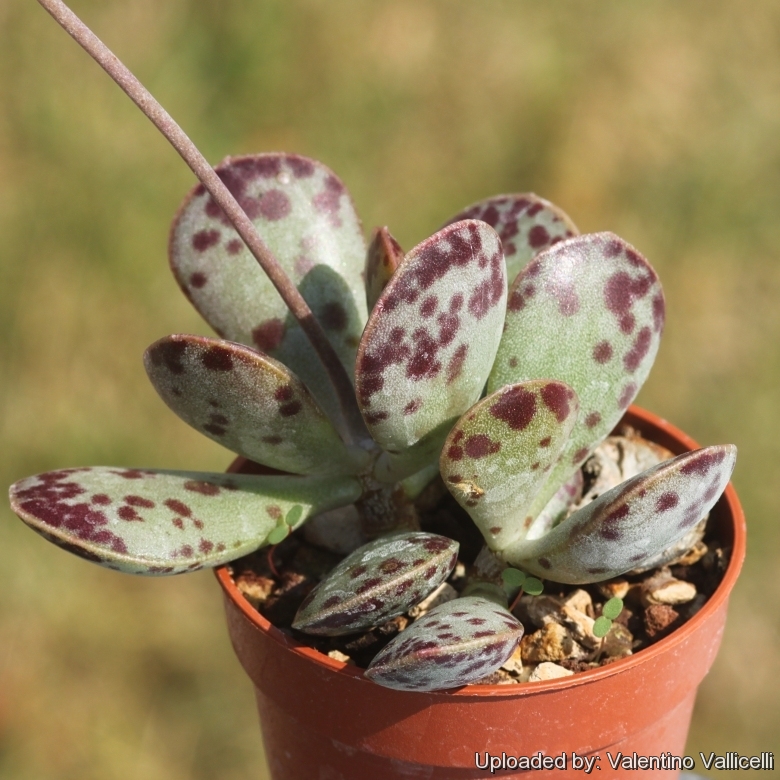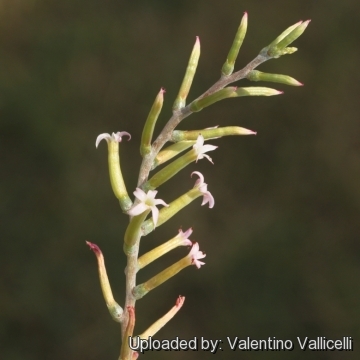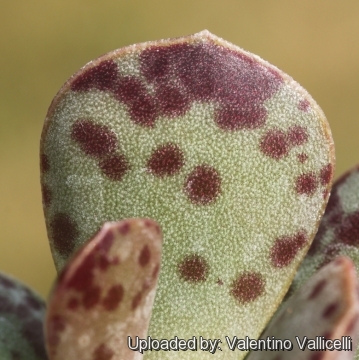
Adromischus maculatus Photo by: Valentino Vallicelli
Origin and Habitat: South Africa, Cape Province, restricted to the Langeberg Mountains from near Worcester to north of George
Habitat: It grows in usually associated with rock outcrops on higher slopes. Ot grows at fairly high altitudes.
Synonyms:
See all synonyms of Adromischus maculatus
back
Accepted name in llifle Database:Adromischus maculatus (Salm-Dyck) Lem.Jard. Fleur. 2(Misc.): 60 1852Synonymy: 4
back
Common Names include:
ENGLISH: Calico Hearts, Chocolate-drop
CHINESE (中文): 御所锦
Description: Adromischus maculatusSN|25598]]SN|25598]] a.k.a. “chocolate-drop” is a nice succulent with fairly flat wedge-shaped leaves, though thick, which are beautifully marked in chocolate colour giving them a marbled appearance.
Habit: Low growing perennials leaf-succulent forming small clusters or mats.
Roots: Fibrous.
Stem: Very short, somewhat woody, decumbent to prostrate up to 15 cm long, little branched
Leaves: Obovate, spatulate or oblanceolate, dorsiventrally flattened, tip obtuse and often mucronate or notched, (25-)30-70(-100) x (15-)20-35(-40) mm, rounded, usually abruptly wedge-shaped but rarely subpetiolate, and with horny margin all round the leaf, green, grey-green to greyish brown, glossy sometimes almost scarlet from the sun rays and with or without dark purple spots, but growing a dark green colour under bushes. The young plants are often without spots.
Inflorescence: A thyrse with l(-2)-flowered cymes, grey-green, erect, 20-35 cm tall.
Flowers: Tubular, pale yellowish green. Corolla-lobes 2,5-5 mm acute, white or tinged pale pink. mauve along margins, spreading to recurred. Lower lobes and throat with club-shaped hairs. Anthers not protruding from corolla-tube Pedicels 2-3 mm long. Buds thin, straight gradually tapered toward tips, spreading.
Flowering season: Summer.
Notes: In the nursery trade Adromischus forms with more-or-less circular (orbicular) leaves were generally called Adromischus maculatusSN|25598]]SN|25598]]; plants with longer, more squared off leaves were called Adromischus cooperiSN|143]]SN|27468]], and plants with spindle-like leaves were called Adromischus festivusSN|25598]]SN|139]], but the stemless "chocolate-drop" Adromischus widely known in collections and in the nursery trade as Adromischus maculatusSN|139]]SN|25598]] is, often one of the forms of Adromischus rupicolaSN|27468]]SN|143]]. The true Adromischus maculatusSN|25598]]SN|25598]] is quite different and in most forms is a tall, ascending plant.
 Adromischus maculatus in habitat South Africa. Photo by: © Plantemania
Adromischus maculatus in habitat South Africa. Photo by: © Plantemania Adromischus maculatus Photo by: Valentino Vallicelli
Adromischus maculatus Photo by: Valentino Vallicelli Adromischus maculatus Photo by: Valentino Vallicelli
Adromischus maculatus Photo by: Valentino VallicelliSend a photo of this plant.The gallery now contains thousands of pictures, however it is possible to do even more. We are, of course, seeking photos of species not yet shown in the gallery but not only that, we are also looking for better pictures than those already present.
Read More... Cultivation and Propagation: Adromischus maculatusSN|25598]]SN|25598]] is a fairly easy succulent to grow and one of the easier Adromischus species tolerating some frost. It develops quite a massive caudex with age, but plant rarely blooms indoors.
Growth rate: This plant is fairly slow at growing.
Soil: It prefer well-drained soil.
Repotting: Repot every other years. All species of this genus are happy in small pots.
Exposure: It grows best in a partially shaded position but tolerate full sun too. It got sunburned moved suddenly to midday sun.
Hardiness: Require a minimum temperature 5°C (But hardy down to -7°C for short periods), with good drainage and dryness in winter to resist the cold.
Watering: It takes more water than cacti, but let the soil dry between soaking, in the wild, it receives rain mostly in spring and fall. Must have very dry atmosphere. Water less in winter but do not allow it to shrivel.
Pest & disease: It is vulnerable to mealybugs and rarely scale. It is prone to rotting from the tuberous base or from dried inflorescences.
Maintenance: As the plant matures, the centre becomes bare. When it does, restart it from side cuttings and throw away the central part.
Propagation: Usually propagate from single leaves (leaf cuttings) or stem cuttings seed propagation is rarely used. Leaves easily root and produce new plants. Twist off a leaf and permit it to dry out a couple of days, lay it on the soil and insert the stem end partially into the soil. The original leaf should not be removed until it has dried up. Try to keep the leaf somewhat upright so that the roots are able to grow downward. If grown in a container, bottom watering by immersing the container is recommended.













